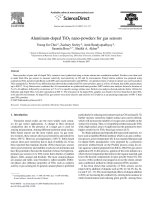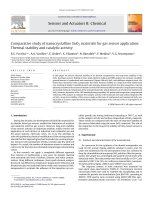- Trang chủ >>
- Khoa Học Tự Nhiên >>
- Vật lý
novel hybrid materials for gas sensing applications made
Bạn đang xem bản rút gọn của tài liệu. Xem và tải ngay bản đầy đủ của tài liệu tại đây (1010.94 KB, 9 trang )
A
vailable online at www.sciencedirect.com
Sensors and Actuators B 131 (2008) 174–182
Novel hybrid materials for gas sensing applications made
of metal-decorated MWCNTs dispersed on
nano-particle metal oxides
R. Ionescu
a
, E.H. Espinosa
a
, R. Leghrib
a
, A. Felten
b
, J.J. Pireaux
b
, R. Erni
c
,
G. Van Tendeloo
c
, C. Bittencourt
d
,N.Ca
˜
nellas
a
, E. Llobet
a,∗
a
MINOS, Universitat Rovira i Virgili, ETSE-DEEEA, Av. Pa¨ısos Catalans 26, E-43007 Tarragona, Spain
b
LISE, Falcult´es Universitaires Notre Dame de la Paix, 61 rue de Bruxelles, B-5000 Namur, Belgium
c
EMAT, University of Antwerp, 171 Groenenborgerlaan, B-2020 Antwerp, Belgium
d
LCIA, Materia Nova, Parc Initialis, Av. Copernic, 1, B-7000 Mons, Belgium
Received 5 July 2007; received in revised form 1 November 2007; accepted 2 November 2007
Available online 31 December 2007
Abstract
Novel hybrid gas-sensitive materials were fabricated by means of metal-decorated multiwall carbon nanotubes (MWCNT) dispersed on nano-
particle metal oxides. The MWCNT were initially functionalized in an oxygen plasma for improving their dispersion and surface reactivity, and then
they were decorated with metal nano-clusters by thermally evaporating gold or silver on the MWCNT. Active layers for gas sensing applications
were obtained by adding a small amount of metal-decorated MWCNT to two different types of metal oxides (SnO
2
and WO
3
). The hybrid materials
have been analyzed by means of XPS, TEM and SEM. The gas sensing potential of the fabricated hybrid materials has been tested upon exposure
to different hazardous species, specifically NO
2
, CO, C
6
H
6
and NH
3
, at low operating temperature.
© 2007 Elsevier B.V. All rights reserved.
Keywords: Gas sensors; Metal-decorated MWCNT; Hybrid metal oxides/MWCNT; Low temperature operation
1. Introduction
Carbon nanotubes (CNT) are receiving nowadays more and
more attention from the gas sensor community [1–4]. A special
characteristic that makes them interesting as active materials
for gas sensors is given by their huge surface area that can be
exposed to gases [5]. Experimental reports have shown that
upon exposure to toxic gases such as NO
2
,NH
3
, CO, ben-
zene or ethanol, the electrical conductance of semiconducting
CNT changes, even when they are operated at low temperatures
[6–8], thus reducing considerably the power consumption of the
sensing device.
However, the agglomeration of CNT into bundles during their
synthesis appears as a drawback for forming a well-dispersed
active layer. To overcome this inconvenience, a plasma func-
∗
Corresponding author. Tel.: +34 977558502; fax: +34 977559605.
E-mail address: (E. Llobet).
tionalization process applied to the CNT has proved to be
efficient [9]. This treatment gives, furthermore, rise to functional
groups attached to the surface of the nanotubes, which modifies
the CNT-surface reactivity and can further improve gas detec-
tion. So far, sensors fabricated with multiwall CNT (MWCNT)
functionalized with oxygen have proved to give good results
when operated at ambient temperature, above all showing good
responsiveness to low concentrations of NO
2
[8].
Anyway, in spite of the observed potential of either untreated
or functionalized MWCNT to detect gases, they show quite
low sensitivities to the hazardous species detected, that can-
not be improved even if the sensor operating temperature is
increased. In order to overcome this drawback, we considered
it worthy to investigate the approach of doping the carbon nan-
otubes with metallic nanoclusters, and we recently reported a
significant improvement of sensitivity to NO
2
when employing
MWCNT decorated with Au or Ag nanoclusters as compared
with the response obtained by un-doped MWCNT [10]. A pre-
vious functionalization process of the carbon nanotubes in an
0925-4005/$ – see front matter © 2007 Elsevier B.V. All rights reserved.
doi:10.1016/j.snb.2007.11.001
R. Ionescu et al. / Sensors and Actuators B 131 (2008) 174–182 175
oxygen plasma provided a more homogeneous distribution of
the metal nanoclusters on the CNT surface as compared with
cluster dispersion on non-treated CNT [11].
On the other hand, metal oxides are well-known materials
suitable for detecting a wide spectrum of gases with enough
sensitivity. Among these materials, SnO
2
and WO
3
have proved
to be very suitable candidates, but when the detection of toxic
species is devised they typically need to be operated at temper-
atures ranging between 200 and 500
◦
C [12,13]. Furthermore,
it is generally known that, in practice, the sensitivity of metal
oxide gas sensors can be enhanced by using bulk dopants
or by the addition of metal clusters to the sensing material
[14].
When metal oxide sensors are operated at high tempera-
tures, changes in the microstructure of the gas-sensitive film are
likely to occur (i.e. structural changes or coalescence [15]). At
higher temperatures, the mobility of oxygen vacancies becomes
appreciable and the mechanism of conduction becomes mixed
ionic–electronic. The diffusion of oxygen vacancies is known to
be a mechanism responsible for long-term drift in metal oxide
gas sensors [16,17]. Therefore, a strategy to avoid long-term
changes in their response could consist in operating the sen-
sors at temperatures low enough so that appreciable structural
variation never occurs, provided that gas reactions occur at a
reasonable rate.
Recently, hybrid films based on tin or tungsten oxide and
carbon nanotubes have been introduced as new gas-sensitive
materials with improved sensitivity [10,18–21]. These works
indicated that the detection at ambient temperature of toxic
gases such as nitrogen dioxide, carbon monoxide and ammonia
or ethanol vapors can be improved by dispersing an adequate
quantity of carbon nanotubes into a metal oxide matrix.
In this paper, we study and discuss the performance in gas
sensing of hybrid materials consisting of Au or Ag decorated
multiwall carbon nanotubes dispersed in a metal oxide matrix
(either SnO
2
or WO
3
is considered for this purpose).
2. Experimental
2.1. Carbon nanotubes functionalization and doping
The MWCNT used in the experiment were obtained from
Mercorp [22]. They were synthesized by arc discharge without
use of catalysts. The MWCNT powder presents 99% of car-
bon with 30–40% nanotube content. They have 8–30 graphene
layers, are 6–20 nm in diameter and 1–5 m in length.
A uniform functionalization with oxygen was applied to the
as-provided carbon nanotubes in order to improve their disper-
sion and surface reactivity. For this activation step the MWCNT
powder was placed inside a glass vessel and a magnet, exter-
nally controlled from the plasma chamber, was used to stir the
nanotubes powder during the plasma treatment. Inductively cou-
pled plasma at a RF frequency of 13.56 MHz was used during
the process [23]. Once the MWCNT powder was placed inside
the plasma glow discharge, the treatment was performed at a
pressure of 0.1 Torr, using a power of 15 W, while the process-
ing time was adjusted to 1 min. A controlled flow of oxygen
was introduced inside the chamber, which gave rise to oxygen
functional groups grafted at the carbon nanotube surface.
In the second processing step, the oxygen functionalized nan-
otubes were decorated with metal nanoclusters by thermally
evaporating gold or silver atoms onto the MWCNT surface from
a gold or silver wire, respectively. The processing parameters
were adjusted to be sufficient enough in order to obtain a fair
dispersion of few metal nanoclusters decorating the MWCNT,
but at the same time to avoid the formation of a metallic layer
covering the carbon nanotubes [11].
2.2. Active layers
Sensing layers were prepared using commercially avail-
able SnO
2
and WO
3
nanopowders (Sigma–Aldrich). Hybrid
materials were obtained by adding two different amounts of
metal-decorated MWCNT to 70 mg of metal oxide, thus obtain-
ing two different proportions of MWCNT embedded into the
metal oxide matrix (1/500 and 1/250 wt%, respectively). An
adequate mixture of the components was obtained by dissolving
them in glycerol (employed as organic vehicle), and stirring the
resulting solution in an ultrasonic bath at 75
◦
C for 2 h. The
amount of nanotubes to be added to the metal oxide matrix
was based on a previous study [20]. The pastes obtained were
dropped onto the electrode area of micro-hotplate transduc-
ers (fabricated at the Centre Nacional de Microelectr
`
onica,
Barcelona, Spain) using a micro-injector (JBE1113 Dispenser,
I&J FISNAR Inc., USA).
The as-deposited sensing films were firstly dried at 140
◦
C
during 2 h in order to burn out the organic vehicle, using a slow
temperature ramp of 2.5
◦
C/min for reaching this temperature
in order to avoid the occurrence of cracks in the films. We used
for this process a lower temperature than the boiling point of
glycerol (i.e., 182
◦
C [24]) in order to avoid producing cracks in
the films deposited. The drying time was however sufficiently
long for the complete evaporation of the organic vehicle. Finally,
the films were annealed in situ at 450
◦
C during 3 h in ambi-
ent atmosphere (this also ensures the complete removal of the
organic vehicle). During the annealing process, the tempera-
ture was raised from ambient to 450
◦
C using again a ramp of
2.5
◦
C/min.
The mean grain size of the metal oxides particles, determined
in a previous study, was near 40 nm [25].
2.3. Material characterization
The chemical composition of the samples’ surfaces was
investigated by means of X-ray photoelectron spectroscopy
(XPS). XPS analyses were performed using an ESCA-300 (SCI-
ENTA, Sweden) photoelectron spectrometer equipped with a
monochromatized Al K␣ = 1486.7 eV. A high-resolution hemi-
spherical electrostatic analyzer of 600 mm diameter and 75 eV
pass energy was used. The angle between the incident X-ray and
the photoelectron take-off direction was 45
◦
, with the latter nor-
mal to the sample surface. The overall resolution of the system
(source + analyzer) was 0.6 eV. The background pressure during
experiment was better than 10
−9
Torr).
176 R. Ionescu et al. / Sensors and Actuators B 131 (2008) 174–182
The size of the metal clusters and their dispersion on the
CNT walls were studied by means of high-resolution transmis-
sion electron microscopy (HRTEM) carried out using a Philips
CM30 FEG instrument operated at 300 kV. In order to reduce
potential knock-on radiation damage caused by the 300 keV
electron beam, the electron dose was significantly decreased
such that during the entire electron-beam exposure no changes
in the nanotubes were observable.
The morphology of the hybrid films deposited onto the
microhotplate substrates was investigated by means of scan-
ning electron microscopy (SEM). SEM measurements were
performed using a Joel JSM 6400 equipment, with a resolution
of 0.3 nm. The magnification during this study was set to values
varying between 30,000 and 50,000. Accelerating voltages of 25
or 30 kV were employed. The system allows for sample rotation
(360
◦
) and sample inclination (90
◦
).
2.4. Gas sensing measurements
The gas sensing properties of the different hybrid active mate-
rials produced were tested in the presence of different hazardous
species, such as CO (carbon monoxide), NO
2
(nitrogen diox-
ide), NH
3
(ammonia) and C
6
H
6
(benzene). The sensors were
operated at three different temperatures: 25 (i.e., ambient), 150
and 250
◦
C. To perform the measurements, the gas sensors were
placed inside a 5.3 dm
3
test chamber, and the desired concen-
trations of each contaminant under study were introduced by
the direct injection method using a gas-tight chromatographic
syringe. Specifically, these concentrations were: 100, 200, 500
and 1000 ppb for NO
2
; 10 and 50 ppm for CO; 2, 5 and 10 ppm
for NH
3
and 50 and 150 ppm for C
6
H
6
. To assess the repro-
ducibility of the results, each measurement was replicated 4
times. An Agilent 34970A multimeter was used for continu-
ously monitoring the electrical resistance of the sensors during
the measurement process. The data acquired were stored in a PC
for further analysis.
The measurement process was as follows (identical for any
species tested): data acquisition started 10 min before injecting
into the measurement chamber the required volume correspond-
ing to the lowest concentration of the contaminant measured.
After reaching a steady state, a new amount of the same con-
taminant was injected, so that the second concentration to be
tested was reached. Successive injections were repeated until
all desired concentrations of the gas were measured. After each
series of successive injections, the sensor chamber was flushed
using pure dry air for 2 h, which ensured the cleaning of both
the chamber and the sensor surface. Finally, the airflow was
interrupted and the sensors were left to recover their baseline
resistance before performing a new set of measurements.
In addition to the previously mentioned measurements, con-
trol gas sensing experiments were carried out employing both
pure WO
3
and pure SnO
2
materials. Furthermore, we reported
recently gas sensing results obtained with Au and Ag deco-
rated MWCNT [10]. The present results are also compared with
previous works performed under the same experimental con-
ditions with WO
3
and SnO
2
films activated with Au and Ag
[25–27].
Fig. 1. XPS spectra recorded before and after oxygen functionalization of
MWCNT.
3. Results and discussion
3.1. Characterization
Fig. 1 shows the XPS survey spectra of the carbon nanotubes
recorded before and after the plasma treatment. The peak at
284.6 eV, observed in both spectra, is generated by photoelec-
trons emitted from the C 1s core level. In the XPS spectrum
recorded after oxygen plasma treatment a peak near 535 eV can
be observed. This peak is generated by photoelectrons emitted
from the O 1s core level. The relative atomic oxygen concentra-
tion evaluated by XPS was found to be 6%.
Fig. 2 shows the XPS spectra recorded on the metal-decorated
carbon nanotubes. After the evaporation of the metals, the XPS
survey spectra showed, in addition to the mean peak situated
at 284.6 eV generated by photoelectrons emitted from the C 1s
peak, a doublet peak near 85.0 eV that was generated by pho-
toelectrons emitted from the Au 4f core levels (Fig. 2a), or one
peak at 370.0 eV generated by photoelectrons emitted from the
Ag 3d core level (Fig. 2b). The interaction between the metal
clusters and the CNT surface can be studied by XPS. If there
is a chemical reaction at the interface, then the new chemical
environment of the atoms at the interface will show in the XPS
spectra by the appearance of new features. In the core level
spectra recorded (Fig. 2, inset) on these samples no additional
features beyond the Ag 3d and Au 4f doublet were observed, thus
no chemical reaction between the carbon and gold or silver atoms
occurs.
The relative atomic concentration of each element, evaluated
by XPS after plasma functionalization and metal evaporation, is
summarized in Table 1. The decrease in the oxygen atomic con-
centration can be associated to the increase in the CNT surface
area that is covered by gold atoms. This reduces the effective
number of C 1s and O 1s photoelectrons passing through the
“gold or silver overlayer” and contributing to the XPS spectrum,
which explains the decrease in the curve for the total number of
photoelectrons emitted.
R. Ionescu et al. / Sensors and Actuators B 131 (2008) 174–182 177
Fig. 2. XPS spectra recorded on metal-decorated MWCNT: (a) Au-decorated;
(b) Ag-decorated.
Fig. 3 shows a typical TEM image recorded on oxygen plasma
treated MWCNT decorated with gold clusters. The presence of
homogeneously dispersed quasi-spherical gold clusters at the
CNT surface can be observed. In the inset, a detailed view of a
gold cluster sitting on the CNT surface is shown. The preserved
structural characteristics of the graphene layer under the gold
cluster are a strong indication of the absence of an Au–C phase
formation.
Similar results (not shown here) were obtained for Ag clusters
evaporated on the CNT surface.
Table 1
Relative atomic concentrations obtained by XPS
[C] (%) [O] (%) [Ag] (%) [Au] (%)
Oxygen
plasma
treated
MWCNTs
94.0 6.0
Au-MWCNTs 92.0 2.7 5.3
Ag-MWCNTs 95.0 3.2 1.8
Fig. 3. TEM image recorded on MWCNT decorated with gold metallic nan-
oclusters deposited by thermal evaporation.
Considering that the interaction between Au or Ag atoms
and the CNT surface was reported to be weak and presumably
of Van der Waals in nature [11], an inspection to evaluate if the
gas sensing layer preparation method employed (i.e., the soni-
cation process applied for obtaining a good mixture of the active
layer components) could affect the dispersion of the metal nan-
oclusters at the CNT surface was performed. For this evaluation,
MWCNTs decorated with metal nanoclusters dispersed in glyc-
erol were analyzed. In this case no metal oxide was used and the
same procedure as the one employed for the fabrication of the
hybrid materials (i.e., stirring the solution in an ultrasonic bath
for 2 h at 75
◦
C) was implemented. Fig. 4 shows a TEM image of
a metal-decorated nanotube having undergone this process. The
presence of metal clusters laying isolated within the deposited
film reveals that the stirring process implemented to obtain a
good dispersion of the metal-decorated MWCNT in the glyc-
erol solution affects the decoration of MWCNT, removing some
of the clusters from the CNT surface. From Fig. 4 it can be seen
Fig. 4. TEM image recorded on Au-decorated MWCNT after a sonication pro-
cess performed during the preparation of the sensing materials.
178 R. Ionescu et al. / Sensors and Actuators B 131 (2008) 174–182
Fig. 5. SEM images recorded on different hybrid films: (a) Ag-MWCNT/WO
3
(1/500 wt%); (b) Ag-MWCNT/SnO
2
(1/250 wt%).
that mainly big clusters are removed from the CNT surface. Fur-
ther studies will be performed to estimate if the cluster removal
is size-selective and if clusters are removed intact or only in part.
It is worth noting that the clusters removed from the CNT
surface during the fabrication of hybrid metal oxides/metal-
decorated CNT will be embedded in the metal oxide matrix.
However, improvements in the sensing properties (e.g., enhanc-
ing their sensitivity, decreasing the operating temperature or
making them more selective to a given target species) have been
reported to be achieved by adding small amounts of noble metals
to the metal oxide active layer [28]. Thus, it can be suggested
that besides the presence of CNTs, the presence of noble metal
Table 2
Responsiveness to NO
2
and CO of the different sensors studied as calculated from Eq. (1)
Film Layer NO
2
(250
◦
C) NO
2
(150
◦
C) NO
2
(25
◦
C)
0.1 ppm 0.5 ppm 1 ppm 0.1 ppm 0.5 ppm 1 ppm 0.1 ppm 0.5 ppm 1 ppm
WO
3
1.98 5.73 7.14 0.19 0.41 0.50 0 0 0
SnO
2
0.81 11.04 15.72 1.01 4.47 4.66 0 0.10 0.10
Au-MWCNT/WO
3
(1:500) 1.39 8.96 21.44 0.35 1.66 2.07 0 0 0
Au-MWCNT/WO
3
(1:250) 0 0 0 −0.03 −0.06 −0.08 −0.03 −0.07 −0.08
Ag-MWCNT/WO
3
(1:500) 1.40 8.00 24.44 0.29 1.51 2.78 0 0 0
Ag-MWCNT/WO
3
(1:250) 0 0 0 −0.01 −0.04 −0.05 −0.03 −0.07 −0.09
Au-MWCNT/SnO
2
(1:500) 47.36 238.56 243.92 10.67 32.34 32.34 0.96 0.98 0.98
Au-MWCNT/SnO
2
(1:250) 73.21 471.21 485.83 30.29 88.91 88.91 1.14 1.14 1.14
Ag-MWCNT/SnO
2
(1:500) 15.24 72.02 96.69 10.34 31.40 31.40 1.04 2.64 2.69
Ag-MWCNT/SnO
2
(1:250) 19.30 98.59 135.79 9.01 16.42 16.42 0.35 0.35 0.35
Au-MWCNT 0 −0.01 −0.02 0 −0.04 −0.07 −0.01 −0.07 −0.09
Ag-MWCNT 0 −0.02 −0.03 −0.01 −0.03 −0.06 −0.01 −0.04 −0.07
Film Layer CO (250
◦
C) CO (150
◦
C) CO (25
◦
C)
10 ppm 50 ppm 10 ppm 50 ppm 10 ppm 50 ppm
WO
3
0.73 0.79 0.27 0.72 0 0
SnO
2
0.07 0.25 0.14 0.34 0 0
Au-MWCNT/WO
3
(1:500) 000000
Au-MWCNT/WO
3
(1:250) 000000
Ag-MWCNT/WO
3
(1:500) 2.34 16.11 0.48 2.51 0 0
Ag-MWCNT/WO
3
(1:250) 0.06 0.05 0 0 −0.02 −0.04
Au-MWCNT/SnO
2
(1:500) 9.32 31.10 4.37 7.50 0 0
Au-MWCNT/SnO
2
(1:250) 25.05 74.59 11.29 17.52 0 0
Ag-MWCNT/SnO
2
(1:500) 15.03 36.76 10.12 16.10 0 0
Ag-MWCNT/SnO
2
(1:250) 14.39 45.18 10.96 16.44 0 0
Au-MWCNT 000000
Ag-MWCNT 000000
R. Ionescu et al. / Sensors and Actuators B 131 (2008) 174–182 179
clusters inside the metal oxide matrices can act improving the
sensing properties.
Fig. 5 shows SEM images recorded on the different hybrid
carbon nanotubes/metal oxide sensing films deposited over the
sensors substrates. The micrographs show the presence of WO
3
and SnO
2
metal oxide grains, whereas carbon nanotubes are
observed only in WO
3
/CNT hybrids. This can be associated to
the low proportion of carbon nanotubes embedded in the metal
oxide matrix (1/500 or 1/250 wt%) as well as to the difference in
density between WO
3
and SnO
2
(7.16 and 6.95 g/cm
3
, respec-
tively [29]); in order to obtain the desired weight proportions
between the metal oxide and CNTs a higher amount of SnO
2
than WO
3
is present in the hybrid materials.
3.2. Gas response analysis
The gas sensing properties of the different hybrid materials
produced were evaluated in terms of the ratio between the change
experienced by the sensor resistance after its exposure to pollu-
tant species and the sensor baseline resistance in air (see Eq. (1),
where S defines sensor’s responsiveness, R
air
sensor’s resistance
in air and R
gas
sensor’s resistance in the presence of the pollutant
after reaching a steady state). Responsiveness results for NO
2
and CO are summarized in Table 2; because no response was
obtained to NH
3
and C
6
H
6
, for space reasons these were not
included in the responsiveness table.
S =
R
air
− R
gas
R
air
(1)
Sensors based on SnO
2
and Au-decorated MWCNT hybrids
were the most sensitive to NO
2
among the different materi-
als studied, outperforming the responsiveness of either pure
SnO
2
or pure Au-decorated MWCNT materials when operating
both at 250 and 150
◦
C. Typical responses of metal-decorated
MWCNT/SnO
2
gas sensors to NO
2
are shown in Fig. 6. The
fluctuation in the response signal that occurs at high NO
2
con-
centrations is due to the increased effect of noise when sensor
resistance becomes very high (i.e. comparable in magnitude to
the input impedance of the multimeter employed to acquire
it). The quantity of nanotubes dispersed in the SnO
2
matrix
was found to play a determinant role in the responsiveness
of the hybrid materials to NO
2
. At a concentration ratio of
1/250 wt%, the responsiveness of the hybrids made of metal-
decorated MWCNT (either using Au or Ag as dopants) and SnO
2
was significantly superior to that with the 1/500 wt% ratio when
the detection of NO
2
at 250
◦
C was aimed at. When the operat-
ing temperature of sensors was lowered to 150
◦
C, the particular
type of metal decorating the carbon nanotubes played also an
important role in the NO
2
detection. Thus, at 150
◦
C a concen-
tration ratio of 1/250 wt% of carbon nanotubes dispersed in the
SnO
2
matrix was the most appropriate when Au was used as
a dopant, while 1/500 wt% of Ag-decorated MWCNT added to
SnO
2
was the most suitable for this latter case. On the other
hand, similar values of responsiveness were found at 150
◦
C for
both Au-MWCNT/SnO
2
and Ag-MWCNT/SnO
2
(1/500 wt%)
materials. Furthermore, it is worth mentioning that the response
of the hybrid films based on SnO
2
became already saturated after
Fig. 6. Response to different hazardous species obtained by gas sensors
employing different hybrid materials: (a) NO
2
detection at 250
◦
C with
Au-MWCNT/SnO
2
(1/250 wt%) sensor; (b) NO
2
detection at 150
◦
C with Au-
MWCNT/SnO
2
(1/250 wt%).
the injection of only 500 ppb of NO
2
at the working temperature
of 150
◦
C (see Fig. 6b).
Regarding the responsiveness towards NO
2
of the hybrid
materials based on WO
3
(see Fig. 7), it was at least one order of
magnitude below the one obtained by the hybrids based on SnO
2
.
The quantity of nanotubes embedded in WO
3
was of impor-
tant relevance. Thus, when the sensors were operated at 250
◦
C,
only metal-decorated MWCNT dispersed in the WO
3
matrix in
a concentration ratio of 1/500 wt% were able to detect NO
2
(the
metal used as a dopant did not change sensor performance in
this case), while at 150
◦
C the semiconducting behaviour of the
metal-decorated MWCNT/WO
3
hybrids changed from n-type
at a concentration ratio of 1/500 wt% to p-type at 1/250 wt%.
For the measurements performed at 250
◦
C, the response time
to 100 ppb and to 500 ppb of NO
2
was around 2 min both for the
hybrid materials based on WO
3
and for the pure WO
3
sensors.
It rose to 3 min in the case of hybrids based on SnO
2
, but in this
latter case it compared very favourably to the one of pure SnO
2
sensors, which did not reach completely a steady state regime
15 min after gas injection. When the sensor operating tempera-
ture was lowered and NO
2
test measurements were performed,
the sensors needed a longer time to reach the steady state. The
response times varied between 6 and 10 min for hybrid sensors
and were over 15 min for pure metal oxide sensors. Recovery
180 R. Ionescu et al. / Sensors and Actuators B 131 (2008) 174–182
Fig. 7. (a) NO
2
detection at 150
◦
C with Ag-MWCNT/WO
3
(1/500 wt%) sensor;
(b) NO
2
detection at 150
◦
C with Ag-MWCNT/WO
3
(1/250 wt%) sensor.
time varied between 10 and 20 min for Au-based hybrid sensors
(see Fig. 6) and was over 30 min for Ag-based hybrids and pure
metal oxide sensors.
The second air pollutant tested was carbon monoxide. The
highest responsiveness in the case of the CO tests was again
achieved by the hybrid sensors based on Au-decorated MWCNT
and SnO
2
in a concentration ratio of 1/250 wt%, operated at
250
◦
C (see Fig. 8). Although lower, some responsiveness was
also obtained at 150
◦
C by the hybrid sensors containing SnO
2
.
Fig. 8. CO detection at 250
◦
C with Au-MWCNT/SnO
2
(1/250 wt%) sensor.
Similarly to the detection of NO
2
, when CO was tested Au-
based hybrid sensors showed response and recovery times of
about 5 min (operated at 250
◦
C), while the response and recov-
ery times of pure metal oxides was higher than 15 min. When
the metal oxide employed was WO
3
, the only hybrid based on
this material that responded to CO was Ag-MWCNT/WO
3
in
the concentration ratio of 1/500 wt% at an operating temperature
of 250
◦
C. When the Ag-MWCNT/WO
3
sensor (concentration
ratio 1/250 wt%) was operated at 250
◦
C, it behaved as an n-
type semiconductor in the presence of CO; operated at 150
◦
C
it did not respond at all to CO; while at room temperature
its behaviour was equivalent to an n-type semiconductor. This
behaviour clearly suggests that not only the amount of carbon
nanotubes present determines the semiconducting character of
the resulting hybrid material, but also that the operating temper-
ature can play an important role in the sensing mechanism.
Unlike oxygen-functionalized MWCNT/SnO
2
hybrid mate-
rials, which showed good responsiveness to NO
2
at room
temperature [30], metal-decorated MWCNT/metal oxide hybrid
materials were not responsive at room temperature.
Regarding the response of the gas sensors to the other two
pollutants tested (i.e., benzene and ammonia), they were not able
to detect the presence of these two contaminants at a concentra-
tion level up to 10 ppm in the case of NH
3
and up to 150 ppm in
the case of C
6
H
6
, for the operating temperatures investigated.
3.3. Discussion
On the basis of the images of the hybrid films recorded by
SEM analyses, it can be derived that MWCNT are embed-
ded within the metal oxide matrix. It has been reported that
in hybrid films, two different depletion layers (and associ-
ated potential barriers) co-exist [18,19]: one depletion layer
is located at the surface of the grains of the metal oxide
film and the other one at the interface between MWCNT and
metal oxide films. Since SnO
2
or WO
3
films behave as n-type
semiconductors and MWCNT films behave as p-type semi-
conductors [8,31], it can be suggested that the hetero-structure
n-SnO
2
/p-MWCNT (n-WO
3
/p-MWCNT) is formed at the inter-
face between tin oxide (tungsten oxide) and carbon nanotubes.
Furthermore, our results indicate that the addition of metal
nanoclusters at the CNT surface plays a fundamental role in
improving the sensing properties. Studies are being performed
to establish if the metal clusters at the CNT surface act lowering
the potential barrier of the depletion layers and/or enhancing
specific gas adsorptions or promoting specific chemical reac-
tions.
Considering the sensitivity of the hybrid films (see Table 2),
it can be derived that the adsorption of NO
2
or CO at the
metal oxide modifies the depletion layer at the surface of
its grains and also at the n-metal oxide/p-MWCNT hetero-
structures. This combined effect may explain the improvement
in responsiveness shown by tin or tungsten oxide-based hybrid
sensors as compared with either pure metal oxides, metal-
decorated CNT based gas sensors [10] or WO
3
or SnO
2
metal
oxides doped with Au or Ag noble metals [25–27]. The results
obtained indicate also that the number of CNT added to the
R. Ionescu et al. / Sensors and Actuators B 131 (2008) 174–182 181
metal oxide matrix has to be extremely small. The best results
were obtained with the SnO
2
/CNT hybrids, when the pres-
ence of the carbon nanotubes was undetectable by normal
SEM analyses. This is in concordance with the results pub-
lished by Wei et al. [18]. We expect that keeping extremely
low the number of CNT added to the metal oxide matrix,
improved results in terms of sensitivity to NO
2
and CO can
be obtained.
The lack of responsiveness observed for NH
3
and C
6
H
6
by the
new hybrid sensors can be associated to the non-appropriateness
of the used combination of materials for detecting such species,
as suggested by Penza et al. [32] who found that Au-CNT is an
appropriate material for detecting NO
2
while Pt-CNT is more
suitable for detecting benzene or ammonia.
4. Conclusions
In this paper we have shown that the addition of a small
quantity of metal-decorated MWCNT to metal oxides can sig-
nificantly improve the detection capability of metal oxide based
sensors and lower the operating temperature.
In particular, micro-sensors based on Au-MWCNT/SnO
2
hybrid films in a concentration ratio of 1/250 wt% showed the
highest sensitivity towards NO
2
and CO, among the different
materials studied. The response mechanism is fully reversible,
since the sensors can recover their baseline resistance after each
exposure to pollutant gases.
Our results suggest that there is an optimum amount of
carbon nanotubes to be added to each particular metal oxide
in order to enhance the responsiveness. Material characteriza-
tion analyses (performed by SEM and TEM) showed that the
nanotubes endured the process of deposition and subsequent
annealing at 450
◦
C in air, but at the same time part of the
metal nanoclusters decorating the nanotube surface were deta-
ched.
Based on these results, the modulation of the width of two
depletion layers existing at the surface of metal oxide grains
and at the interface of metal oxide grains and MWCNT, respec-
tively, is postulated as the mechanism that could explain the
enhanced performance of hybrid metal oxide/MWCNT sen-
sors in comparison with pure metal oxide or pure MWCNT
sensors.
Acknowledgements
This work was funded in part by the Spanish Commis-
sion for Science and Technology (CICYT) under grant no.
TIC2006-03671/MIC. E.H. Espinosa and R. Leghrib gratefully
acknowledge Ph.D. studentships from Rovira i Virgili Univer-
sity. R. Ionescu holds a ‘Juan de la Cierva’ research fellowship
funded by the Spanish Ministry for Science and Education. Parts
of this work are directly connected to the Belgian Program on
Interuniversity Attraction Poles (PAI5/1/1) on Quantum Size
Effects in Nanostructured Materials, sponsored by the Commu-
naut
´
e Franc¸aise de Belgique.
References
[1] S. Chopra, A.M. Rao, Selective gas detection using a carbon nanotube
sensor, Appl. Phys. Lett. 83 (2003) 2280–2282.
[2] C. Cantalini, L. Valentini, I. Armentano, L. Lozzi, J.M. Kenny, S. San-
tucci, Sensitivity to NO
2
and cross-sensitivity analysis to NH
3
, ethanol
and humidity of carbon nanotubes thin film prepared by PECVD, Sens.
Actuators B 95 (2003) 195–202.
[3] J. Li, Y. Lu, Q. Ye, M. Cinke, J. Han, M. Meyyappan, Carbon nanotube
sensors for gas and organic vapor detection, Nano Lett. 3 (2003) 929–933.
[4] Y. Lu, C. Partridge, M. Meyyappan, J. Li, A carbon nanotube sensor array
for sensitive gas discrimination using principal component analysis, J.
Electroanal. Chem. 593 (2006) 105–110.
[5] O.K. Varghese, P.D. Kichambre, D. Gong, K.G. Ong, E.C. Dickey, C.A.
Grimes, Gas sensing characteristics of multi-wall carbon nanotubes, Sens.
Actuators B 81 (2001) 32–41.
[6] L. Valentini, C. Cantalini, I. Armentano, J.M. Kenny, L. Lozzi, S. Santucci,
Highly sensitive and selective sensors based on carbon nanotubes thin films
for molecular detection, Diamond Relat. Mater. 13 (2004) 1301–1305.
[7] S.G. Wang, Q. Zhang, D.J. Yang, P.J. Sellin, G.F. Zhong, Multi-walled car-
bon nanotube-based gas sensor for NH
3
detection, Diamond Relat. Mater.
13 (2004) 1327–1332.
[8] R. Ionescu, E.H. Espinosa, E. Sotter, E. Llobet, X. Vilanova, X. Correig,
A. Felten, C. Bittencourt, G. Van Lier, J C. Charlier, J.J. Pireaux, Oxygen
functionalisation of MWNT and their use as gas sensitive thick-film layers,
Sens. Actuators B 113 (2006) 36–46.
[9] N.O.V. Plank, R. Cheung, Functionalisation of carbon nanotubes for molec-
ular electronics, Microelectron. Eng. 73/74 (2004) 578–582.
[10] E.H. Espinosa, R. Ionescu, C. Bittencourt, A. Felten, R. Erni, G. Vantende-
loo, J J. Pireaux, E. Llobet, Metal-decorated multi-wall carbon nanotubes
for low temperature gas sensing, Thin Solid Films 515 (2007) 8322–8327.
[11] A. Felten, C. Bittencourt, J F. Colomer, G. Van Tendeloo, J J. Pireaux,
Nucleation of metal clusters on plasma treated multi wall carbon nanotubes,
Carbon 45 (2007) 110–116.
[12] I. Simon, N. Barsan, M. Bauer, U. Weimar, Micromachined metal oxide
gas sensors: opportunities to improve sensor performance, Sens. Actuators
B 73 (2001) 1–26.
[13] M. Graf, D. Barrettino, K U. Kirstein, A. Hierlemann, CMOS micro-
hotplate sensor system for operating temperatures up to 500
◦
C, Sens.
Actuators B 117 (2006) 346–352.
[14] W. G
¨
opel, New materials and transducers for chemical sensors, Sens. Actu-
ators B 18 (1994) 1–21.
[15] E. Comino, Metal oxide next term nano-crystals for gas sensing, Anal.
Chim. Acta 568 (2006) 28–40.
[16] P.K. Clifford, D.T. Tuma, Characteristics of semiconductor gas sensors. 1.
Steady-state gas response, Sens. Actuators 3 (1983) 233–254.
[17] P.K. Clifford, D.T. Tuma, Characteristics of semiconductor gas sensors.
2.Transient-response to temperature-change, Sens. Actuators 3 (1983)
255–281.
[18] B.Y. Wei, M.C. Hsu, P.G. Su, H.M. Lin, R.J. Wu, H.J. Lai, A novel SnO
2
gas sensor doped with carbon nanotubes operating at room temperature,
Sens. Actuators B 101 (2004) 81–89.
[19] Y. Chen, C. Zhu, T. Wang, The enhanced ethanol sensing properties of
multi-walled carbon nanotubes/SnO
2
core/shell nanostructures, Nanotech-
nology 17 (2006) 3012–3017.
[20] C. Bittencourt, A. Felten, E.H. Espinosa, R. Ionescu, E. Llobet, X. Correig,
J J. Pireaux, WO
3
films modified with functionalised multi-wall carbon
nanotubes: Morphological, compositional and gas response studies, Sens.
Actuators B 115 (2006) 33–41.
[21] E.H. Espinosa, R. Ionescu, E. Llobet, A. Felten, C. Bittencourt, E. Sotter,
Z. Topalian, P. Heszler, C.G. Granqvist, J.J. Pireaux, X. Correig, Highly
selective NO
2
gas sensors made of MWCNTs and WO
3
hybrid layers, J.
Electrochem. Soc. 154 (2007) J141–J149.
[22] .
[23] C. Lefebvre, J. Verbist, Characterization of acrylonitrile plasma-
polymerized on carbon fibers, Adv. Comp. Mat. Lett. 1 (1992) 34–37.
[24] />/49770?LastFive.
182 R. Ionescu et al. / Sensors and Actuators B 131 (2008) 174–182
[25] P. Ivanov, E. Llobet, F. Blanco, A. Vergara, X. Vilanova, I. Gracia, C. Can
´
e,
X. Correig, On the effects of the materials and the noble metal additives to
NO
2
detection, Sens. Actuators B 118 (2006) 311–317.
[26] M. Stankova, X. Vilanova, J. Calderer, E. Llobet, J. Brezmes, I. Gr
`
acia, C.
Can
´
e, X. Correig, Sensitivity and selectivity improvement of rf sputtered
WO
3
microhotplate gas sensors, Sens. Actuators B 113 (2006) 241–248.
[27] M. Penza, G. Cassano, F. Tortorella, Gas recognition by activated WO
3
thin-film sensors array, Sens. Actuators B 81 (2001) 115–121.
[28] S. Santucci, C. Cantalini, M. Crivellari, L. Lozzi, L. Ottaviano, M. Pas-
sacantando, X-ray photoemission spectroscopy and scanning tunneling
spectroscopy study on the thermal stability of WO
3
thin films, J. Vac. Sci.
Tech. A 18 (2000) 1077–1082.
[29] .
[30] E.H. Espinosa, R. Ionescu, B. Chambon, G. Bedis, E. Sotter, C.
Bittencourt, A. Felten, J J. Pireaux, X. Correig, E. Llobet, Low tem-
perature gas detection with hybrid metal oxides/MWCNTs, in: XX
Eurosensors Conference Aniversary, G
¨
oteborg, Sweden, September 17–20,
2006.
[31] L. Valentini, I. Armentano, J.M. Kenny, C. Cantalini, L. Lozzi, S. Santucci,
Sensors for sub-ppm NO
2
gas detection based on carbon nanotube thin
films, Appl. Phys. Lett. 82 (2003) 961–963.
[32] M. Penza, G. Cassano, R. Rossi, M. Alvisi, A. Rizzo, M.A. Signore, Th.
Dikonimos, E. Serra, R. Giorgi, Enhancement of sensitivity in gas chemire-
sistors based on carbon nanotube surface functionalized with noble metals
(Au, Pt) nanoclusters, Appl. Phys. Lett. 90 (2007) 173–176.
Biographies
Radu Ionescu is a postdoctoral research fellow at the Department of Electronics,
Electrical and Automatic Engineering, Rovira i Virgili University, Tarragona,
Spain. His main research interests are in the field of chemical gas sensors, carbon
nanotubes and pattern recognition.
Edwin Espinosa is a PhD student at the Department of Electronics, Electrical
and Automatic Engineering, Rovira i Virgili University, Tarragona, Spain. His
research topic consists of gas sensors based on plasma functionalised carbon
nanotubes.
Radouane Leghrib is a PhD student at the Department of Electronics, Electrical
and Automatic Engineering, Rovira i Virgili University, Tarragona, Spain. His
research topic consists of gas sensors based on carbon nanotubes decorated with
metal nanoclusters.
Alexandre Felten is a postdoctoral research fellow at the LISE laboratory,
University of Namur, Belgium. One of his research interests is in the func-
tionalisation of carbon nanotubes using cold plasmas.
Jean Jacques Pireaux is the director of the LISE laboratory, University of
Namur, Belgium. Professor Pireaux leads a project on the interface design of
metal nanocluster-carbon nanotube hybrids via control of structural and chemi-
cal defects in a plasma discharge.
Rolf Erni is a researcher at the EMAT, University of Antwerp, Belgium. His
main areas of interest are in Electron scattering and diffraction physics, aber-
ration correction in TEM and STEM, low-loss and high-resolution electron
energy-loss spectroscopy, functional materials such as optically active materials,
nanomaterials such as quantum dots, quantum well structures and nanoparticles.
Gustav Van Tendeloo is professor of physics at the University of Antwerp,
Belgium. His main research interest are in superconducting and CMR materials,
ceramic thin films, nanotubes, nanowires, nanobelts, nanoparticles and meso-
porous materials, GaN and related semiconductors, solid state phase transitions
and modulated structures.
Carla Bittencourt is a senior researcher at the LCIA, University of Mons-
Hainaut, Belgium. One of her research interest is in the development of metal
oxide and carbon nanotube hybrid materials for sensing gases at low operating
temperatures.
Eduard Llobet is an associate professor of electronics at the University Rovira i
Virgili (Tarragona, Spain). His main research interests are in the fabrication and
modelling of semiconductor gas sensors and in the applications of intelligent
systems to complex odour analysis.
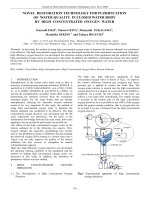
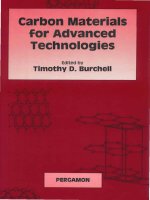



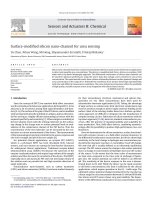
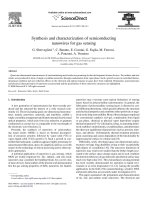
![Study materials for MIT course [22 101] applied nuclear physics](https://media.store123doc.com/images/document/14/rc/jx/medium_DLiOAYd9bs.jpg)
